Video of the Week:
Dividing Peonies to Share
Pests:
Garden Spiders
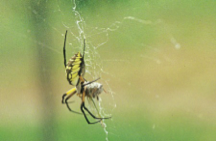
There are actually two common species of garden spiders in Kansas that are active during the day. The yellow garden spider has a black abdomen with yellow to yellow-orange markings. The black legs have a yellow or reddish band.
The banded garden spider has numerous bands on both the abdomen and legs. Those on the abdomen are alternating white and dark bands. The legs have alternating black and orange bands.
Both of these spiders are orb weavers that spin large webs with the typical spider web shape. Though these garden spiders have poor eyesight, they are extremely sensitive to vibrations that pass through the web and use this sensitivity to capture their prey. Since these spiders are beneficial and harmless to humans, it is recommended that they be left alone. (Ward Upham)
Flowers:
Reblooming Christmas and Thanksgiving Cacti
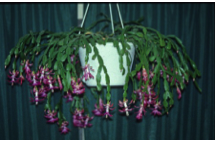
Flowering will not occur unless induced by temperature and light treatment. If the temperature is held at 50 to 55 degrees F, flowering will occur regardless of day length. But flowering usually is not uniform. Temperatures below 50 degrees F prevent flowering. Nights greater than 12 hours long and temperatures between 59 and 69 degrees also can generate flowers. Twenty-five consecutive long nights is enough for flower initiation. Nights will naturally become greater than 12 hours close to the fall equinox, which is on September 23 this year. A plant receiving natural sunlight but no artificial light during night hours, will have this 25-day requirement met about October 20. It takes an additional nine to 10 weeks for flowers to complete development and bloom. Both of these cacti like bright indirect light. Too much sun may cause leaves to turn yellow.
Common household temperatures are fine. Keep soil constantly moist but not waterlogged. These plants seem to flower best if kept a little pot bound. If you need to repot, try waiting until spring. (Ward Upham)
Vegetables:
Harvesting Sweet Potatoes
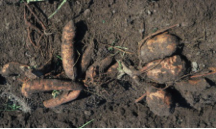
Sweet potatoes should be cured after being dug. The digging process often damages the tender skin, and curing helps these small wounds heal. Place the roots in a warm, humid location for 5 to 10 days immediately after digging. A location with a temperature around 85 to 90 degrees is ideal. A space heater can be used to heat a small room or other area. Raise the humidity by placing moist towels in the room. The curing process not only heals wounds but also helps convert starches to sugars. This process improves the texture and flavor of the roots.
Sweet potatoes should be stored above 55 degrees. Storage at temperatures below that injures the roots, shortens storage life and gives them an off flavor. (Ward Upham)
Ornamentals:
Honeydew
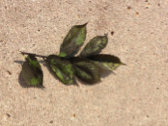
Sooty mold turns anything on which it grows a black color, making it much more objectionable to people. We normally do not recommend control of these insects because populations are usually controlled naturally. Adverse environmental conditions, predators, parasites, and fungal diseases often cause populations to crash. But if you feel control is necessary, a heavy spray of water will help remove insects and honeydew from small plants. A wide range of insecticides, such as acephate (Orthene), horticultural oils, and malathion are labeled and can be used on larger plants, but again this is rarely necessary. (Ward Upham)
September Sedum
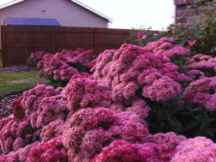
I’m a huge fan of succulent plants. These are plants that thrive in low moisture environments by storing water in their leaves and stems. This means they prefer neglect as their method of care (Yay!). Until recently, they were reserved for niche collectors and were rather difficult to locate. Lately, they have become mainstream and are easily available, even at the grocery store.
In fact, I have no less than six books on my shelf related to succulents: Hardy Succulents (Kelaidis), Succulents for the Contemporary Garden (Cave), Succulents Simplified (Baldwin), Succulent Container Gardens (Baldwin), Cactus and Succulents: A Care Manual (Mace) and Crazy About Cacti and Succulents (Brooklyn Botanic Garden). Most people think primarily of barrel cacti when they consider succulents, but there are so many more forms available for the home gardener! Many can handle snow and all can handle heat and drought. Most prefer full sun.
Fall, however, brings the showy border sedum varieties into full beauty. As perennials, they die back to the ground in the winter, but emerge in the spring with the daffodils as little round tuffets of fleshy, blue-green, basal plant growth. Left alone without any additional water, Sedum spectabile and Sedum telephium will grow 28 to 36 inches tall. Their lovely inflorescences (often more than 5 inches across) are open for weeks—maybe even the whole month. Usually pink or coppery in color, they attract a great variety of pollinators (butterflies, honeybees, etc.) to the late season garden. For those of you interested in sustaining the honeybee population, this is an excellent plant to cultivate for the last little bit of nectar before winter sets in.
You’re probably most familiar with Sedum ‘Autumn Joy.’ This cultivar was introduced in 1955 and continues to be relatively maintenance free. “Relatively” because if the plants get too much water (as was the case this year), they can be overcome by their own weight resulting in lodging (flopping) to the side. This can be disappointing. I planted ‘Autumn Fire’ in my home landscape with the understanding that it was supposed to be less likely to lodge. It, sadly, was not in my well-watered yard. However, a little maintenance can help the plants stand up under the weight of their flowers. It’s scary, I know, but you’ve got to cut them at the base at least once between May and June (hedge shears or hand pruners work great for this task). I’ve been experimenting with this in my yard. They were truly glorious the first year, except for the few plants that lodged. So, the second year I cut them back to about six inches once in May. They still flopped. The year after I tried cutting them to the ground once. It was better. This year I cut them back to the ground twice (beginning of May and end of June) and they’ve stayed a tidy 15 inches tall with no lodging. The idea behind this is that by cutting the stems there are more branches supporting a greater number of smaller inflorescences. Spread out the work of flowering over more stems. The volume of flower show is the same, but the distribution is slightly different.
Meanwhile, my neighbor down the street does no maintenance and his sedum look fine. The only difference, I think, is neglect. I have got to do more of that!
So, I’ve been admiring other sedum varieties lately. Some are statelier in stature with fewer, but sturdier stems. Others are lower to the ground, serving as groundcovers. I like them all and I keep loving all the new cultivars that are released every year. They’re kinda like Lay’s potato chips: You can’t just plant one.
I haven’t decided if I like the short height of my sedum plants this year or prefer to let them get taller. I think I’ll probably lean toward cutting once (at the base) and living with a little lodging if it happens. Or, maybe just water less. How about that? Ultimately, I enjoy them enough to keep playing with the maintenance. I take pleasure in gardening and all the tasks that come with it so I’ll keep tinkering. Fortunately, sedum is one of the few plants that can thrive with either neglect or love. Can’t argue with that. (Cheryl Boyer)
Miscellaneous:
Harvesting and Roasting Sunflower Seeds
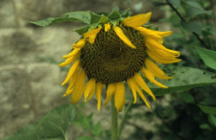
– Florets in the brown center of the flower disk should be shriveled.
– Heads should have turned down.
– The backside of the head should be lemon yellow.
The ultimate check, of course, is to pull a few seeds to see if they have turned black with white stripes, the typical color. Empty shells usually indicate a lack of pollination earlier in the year. If heads are to remain uncovered, harvest when a few seeds start turning black and white. The flavor will not be good as when seeds are allowed to ripen on the plants, but fewer seeds will be lost.
Cut the heads and place in a paper sack. Some people prefer to cut the heads with about a foot of stem attached and hang them upside down in a dry, well-ventilated area. A paper bag or cheesecloth can be placed over the heads to prevent seeds from dropping as they dry. Seeds can be easily removed from dry heads by rubbing gently.
Roasting Seeds
Raw, mature seeds may be prepared at home by covering unshelled seeds with salted water (2quarts of water to 1/4 to 2 cup salt). Bring to a boil and simmer 2 hours, or soak in the salt solution overnight. Drain and dry on absorbent paper.
Put sunflower seeds in a shallow pan in a 300-degree F oven for 30 to 40 minutes or until golden brown, stirring occasionally. Take seeds out of the oven and add 1 teaspoon of melted butter or margarine, or cooking oil per 1 cup of seeds if they are to be eaten immediately. Stir to coat. Put on an absorbent towel. Salt to taste. (Ward Upham)
Ornamental Sweet Potatoes
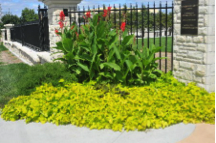
Contributors: Cheryl Boyer, Nursery Crops Specislist; Ward Upham, Extension Associate
 RSS Feed
RSS Feed
